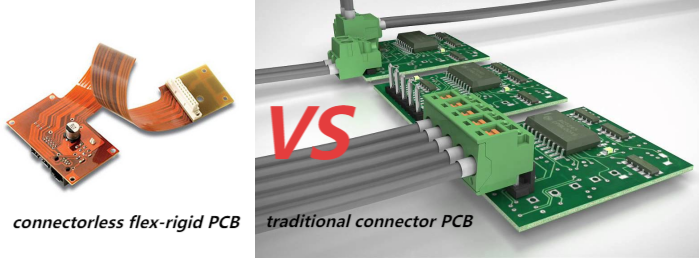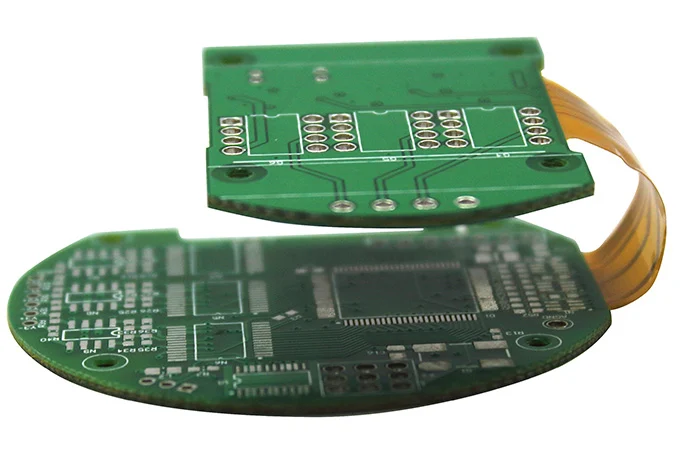In the fast-evolving world of electronics, the demand for reliable, compact, and efficient interconnects is higher than ever. Traditional connectors often introduce points of failure, increase assembly costs, and take up valuable space. This is where connectorless PCB design and rigid-flex PCB connector replacement come into play. By leveraging flex-to-rigid transitions, engineers can create high-reliability interconnects that transform the way devices are designed and manufactured. In this blog, we’ll dive deep into how these innovative designs are revolutionizing electronic interconnects, exploring the rigid-flex PCB advantages and their impact on modern electronics.
What Are Connectorless Designs and Flex-to-Rigid Transitions?
Connectorless designs eliminate the need for traditional physical connectors by integrating flexible circuits directly with rigid boards. This approach, often achieved through flex-to-rigid transitions, combines the durability of rigid PCBs with the adaptability of flexible circuits. These transitions create a seamless connection within a single board, reducing the risk of mechanical failure and signal loss that often occurs at connector interfaces.
Flex-to-rigid transitions are a cornerstone of rigid-flex PCB technology. They allow a single board to bend and fold in specific areas while maintaining structural integrity in others. This design not only saves space but also enhances reliability, making it ideal for applications in aerospace, medical devices, and consumer electronics where high-reliability interconnects are critical.
Why Move Away from Traditional Connectors?
Traditional connectors, while functional, come with several drawbacks that can hinder performance in modern electronic systems. These include:
- Mechanical Failure Points: Connectors are prone to wear and tear, especially in environments with vibration or thermal cycling. Over time, this can lead to intermittent connections or complete failure.
- Signal Integrity Issues: Connectors can introduce impedance mismatches, leading to signal degradation. For high-speed applications, this can result in data loss or reduced performance, with impedance mismatches sometimes exceeding 10% at connector interfaces.
- Space Constraints: Connectors add bulk to a design, which is a significant issue in compact devices like wearables or IoT sensors.
- Cost and Assembly Time: Using connectors increases material costs and requires additional assembly steps, driving up production expenses by as much as 15-20% in some cases.
By adopting connectorless PCB design, engineers can address these challenges head-on, creating more robust and efficient systems.

The Core Advantages of Rigid-Flex PCB Designs
Rigid-flex PCBs with connectorless transitions offer a host of benefits that make them a game-changer for electronic interconnects. Let’s explore the key rigid-flex PCB advantages in detail.
1. Enhanced Reliability for Critical Applications
In applications where failure is not an option—such as medical implants or aerospace systems—high-reliability interconnects are essential. Rigid-flex designs eliminate the weak points associated with connectors, reducing the risk of disconnection due to shock or vibration. Studies show that rigid-flex boards can withstand up to 10,000 flex cycles without significant performance degradation, compared to traditional connectors that may fail after just a few hundred cycles under similar conditions.
2. Improved Signal Integrity
Signal integrity is a major concern in high-speed electronics. Connectorless designs minimize impedance discontinuities, ensuring cleaner signal transmission. For instance, in high-frequency applications, rigid-flex transitions can maintain signal integrity at speeds exceeding 10 Gbps, whereas traditional connectors often struggle to keep signal loss below 3 dB at these speeds. This makes them ideal for data-intensive devices like servers and communication equipment.
3. Space and Weight Savings
By integrating flexible and rigid sections into a single board, rigid-flex designs drastically reduce the need for additional components. This can shrink the overall footprint of a device by up to 50% in some cases, making them perfect for compact electronics like smartphones and wearable tech. Additionally, the reduced component count lowers the overall weight, which is a critical factor in industries like aerospace where every gram counts.
4. Cost Efficiency in the Long Run
While the initial design and fabrication of rigid-flex PCBs may be more complex, they often lead to cost savings over time. Eliminating connectors reduces material costs and simplifies assembly, cutting down on labor expenses. Furthermore, the enhanced durability of these boards means fewer repairs and replacements, saving money on maintenance. For high-volume production, this can translate to savings of thousands of dollars annually.
How Flex-to-Rigid Transitions Enable Connectorless Designs
The magic of connectorless PCB design lies in the seamless integration of flexible and rigid materials. Flex-to-rigid transitions are achieved through advanced manufacturing techniques that bond flexible polyimide layers with rigid FR4 or other substrates. This creates a single, unified structure that can bend where needed while providing stability in critical areas.
These transitions allow signals to flow uninterrupted across the board without the need for external connectors. For example, in a foldable smartphone, a rigid-flex PCB can connect the display to the mainboard through a flexible section that bends with the hinge, eliminating the need for a bulky connector that could fail over time.
Moreover, the manufacturing process ensures that the transition areas are reinforced to prevent cracking or delamination, even after repeated flexing. This durability is vital for devices that undergo constant movement or stress, ensuring consistent performance over the product’s lifespan.
Applications of Connectorless Rigid-Flex Designs
The versatility of rigid-flex PCBs with connectorless transitions makes them suitable for a wide range of industries. Here are some key applications where they shine:
- Consumer Electronics: Devices like smartphones, smartwatches, and earbuds benefit from the compact size and flexibility of rigid-flex designs, allowing for innovative form factors without sacrificing reliability.
- Medical Devices: In wearable health monitors and implantable devices, rigid-flex PCBs provide high-reliability interconnects that can withstand the body’s dynamic environment while maintaining signal accuracy.
- Aerospace and Defense: The lightweight and durable nature of rigid-flex boards makes them ideal for satellites, drones, and military equipment, where they must endure extreme conditions like temperature swings and vibrations.
- Automotive Systems: Modern vehicles rely on complex electronics for everything from infotainment to autonomous driving. Rigid-flex designs help save space in tight engine compartments and ensure reliable performance under harsh conditions.

Design Considerations for Rigid-Flex Connectorless Interconnects
While the benefits of rigid-flex PCB connector replacement are clear, designing these systems requires careful planning to ensure optimal performance. Here are some key factors to keep in mind:
1. Material Selection
Choosing the right materials is critical for balancing flexibility and rigidity. Polyimide is commonly used for flexible sections due to its high thermal stability and durability, while FR4 is a popular choice for rigid areas because of its strength and cost-effectiveness. The transition zones must be carefully engineered to prevent stress concentration, which could lead to cracking over time.
2. Bend Radius and Flex Cycles
The flexible sections of a rigid-flex PCB must be designed with an appropriate bend radius to avoid damage. A general rule of thumb is to maintain a bend radius of at least 10 times the thickness of the flexible material. Additionally, designers should consider the expected number of flex cycles the board will endure during its lifetime to ensure it meets durability requirements.
3. Signal Routing and Layer Stack-Up
Proper signal routing is essential to maintain integrity across flex-to-rigid transitions. High-speed signals should avoid crossing bend areas where possible, as repeated flexing can impact trace performance. A well-planned layer stack-up can also help minimize noise and crosstalk, ensuring stable operation even in complex designs.
4. Manufacturing Expertise
Fabricating rigid-flex PCBs requires specialized equipment and expertise. Partnering with an experienced manufacturer ensures that the transition areas are properly bonded and that the board meets tight tolerances. This is especially important for high-reliability applications where even minor defects can lead to catastrophic failures.
Challenges and Limitations of Connectorless Designs
Despite their many advantages, connectorless rigid-flex designs are not without challenges. The initial design phase can be more complex and time-consuming compared to traditional methods, requiring advanced software tools and skilled engineers. Additionally, the cost of prototyping and small-batch production may be higher due to the specialized processes involved.
However, these challenges are often outweighed by the long-term benefits, especially for high-volume or mission-critical applications. As manufacturing technologies continue to advance, the cost and complexity of rigid-flex designs are expected to decrease, making them accessible to a broader range of projects.
The Future of Electronic Interconnects with Rigid-Flex Technology
The shift toward connectorless PCB design and flex-to-rigid transitions is just the beginning. As industries push for smaller, faster, and more reliable electronics, rigid-flex technology will play an increasingly important role. Innovations in materials, such as the development of ultra-thin flexible substrates, are already expanding the possibilities for even more compact and durable designs.
Furthermore, the rise of 5G, IoT, and wearable technology is driving demand for high-reliability interconnects that can handle high-speed data and operate in challenging environments. Rigid-flex PCBs are uniquely positioned to meet these needs, offering a future-proof solution for next-generation electronics.

Conclusion: Revolutionizing Interconnects with Rigid-Flex Solutions
The move to connectorless designs through flex-to-rigid transitions marks a significant leap forward in electronic interconnect technology. By eliminating traditional connectors, engineers can create systems that are more reliable, compact, and cost-effective. The rigid-flex PCB advantages—from enhanced signal integrity to space savings—make this approach a powerful tool for tackling the challenges of modern electronics.
Whether you’re designing a cutting-edge wearable or a critical aerospace component, rigid-flex technology offers a path to innovation. By embracing rigid-flex PCB connector replacement, you can build products that not only meet today’s demands but also stand the test of time. Partnering with a trusted manufacturer ensures that your designs are brought to life with precision and quality, paving the way for success in an increasingly connected world.



